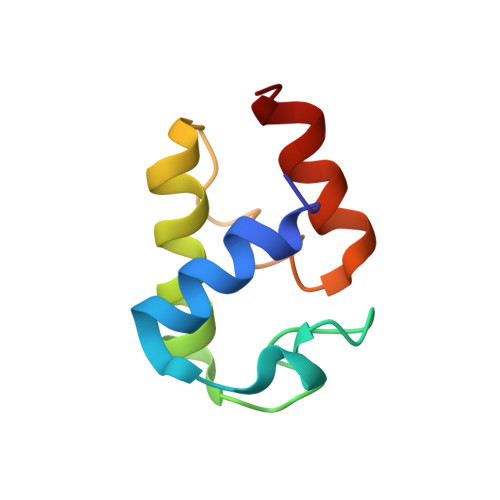Solution structures of conformationally equilibrium forms of holo-acyl carrier protein (PfACP) from Plasmodium falciparum provides insight into the mechanism of activation of ACPs
Sharma, A.K., Sharma, S.K., Surolia, A., Surolia, N., Sarma, S.P.(2006) Biochemistry 45: 6904-6916
- PubMed: 16734426
- DOI: https://doi.org/10.1021/bi060368u
- Primary Citation of Related Structures:
2FQ0, 2FQ2 - PubMed Abstract:
Acyl Carrier Protein (ACP) from the malaria parasite, Plasmodium falciparum (PfACP) in its holo form is found to exist in two conformational states in solution. Unique 3D solution structures of holo-PfACP have been determined for both equilibrium conformations, using high-resolution NMR methods. Twenty high-resolution solution structures for each of the two forms of holo-PfACP have been determined on the basis of 1226 and 1218 unambiguously assigned NOEs (including NOEs between 4'-phosphopantetheine prosthetic group (4'-PP) and protein), 55 backbone dihedral angles and 26 hydrogen bonds. The atomic rmsd values of the determined structures of two equilibrium forms, about the mean coordinates of the backbone and heavy atoms, are 0.48 +/- 0.09 and 0.92 +/- 0.10 and 0.49 +/- 0.08 and 0.97 +/- 0.11 A, respectively. The interaction of 4'-PP with the polypeptide backbone is reported here for the first time for any of the ACPs. The structures of holo-PfACP consist of three well-defined helices that are tightly packed. The structured regions of the molecule are stabilized by extensive hydrophobic interactions. The difference between the two forms arises from a reorientation of the 4'-PP group. The enthalpy difference between the two forms, although small, implies that a conformational switch is essential for the activation of holo-ACP. Sequence and structures of holo-PfACP have been compared with those of the ACPs from type I and type II fatty acid biosynthesis pathways (FAS), in particular with the ACP from rat and the butyryl-ACP from E. coli. The PfACP structure, thus determined has several novel features hitherto not seen in other ACPs.
Organizational Affiliation:
Molecular Biophysics Unit, Indian Institute of Science, Bangalore 560012, India.















